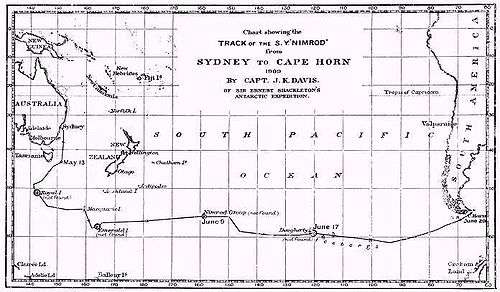Dougherty Island
Dougherty is the name of a phantom island that was believed to be located in the extreme south of the Pacific Ocean, roughly halfway between Cape Horn and New Zealand. It is named for Captain Dougherty of the James Stewart, an English whaler, who in 1841 reported discovering it at 59°20′S 120°20′W. He described it as 5–6 miles long with a high bluff to the northeast and covered in snow. Dougherty's discovery was confirmed by Captain Keates of the Louise in 1860, giving its coordinates as 59°20′S 120°18′W, and by Captain Stannard of the Cingalese in 1886, giving the location as 59°21′S 119°7′W.[1]


However, thorough exploration of the area in the late 19th and early 20th centuries established that the island does not exist.[2] Captain Davis of the Nimrod suggested that the most likely explanation was that Dougherty, Keates, and Stannard had all been deceived by fog banks or icebergs (none, after all, claimed to have actually landed on the island): "I am inclined to think Dougherty Island has melted."[3]
See also
- Royal Company's Islands
- Emerald Island (phantom)
- Nimrod Islands
- Sandy Island, New Caledonia, a phantom island that remained on many maps until the early 21st century
References
- Stommel, Henry (1984). Lost Islands: The Story of Islands That Have Vanished from Nautical Charts. Vancouver: University of British Columbia Press. ISBN 0-7748-0210-3.
- Davis, J.K. (Dec 1910). "Voyage of the S. Y. "Nimrod.": Sydney to Monte Video Viâ Macquarie Island, May 8-July 7, 1909" (PDF). The Geographical Journal. Blackwell Publishing. 36 (6): 696–703. doi:10.2307/1776845. JSTOR 1776845.
- Davis, J. K. (1909). "The Nimrod's homeward voyage in search of doubtful islands". The Heart of the Antarctic. II. Philadelphia: J. B. Lippincott Company.
- Hamilton-Paterson, James. The Great deep: the sea and its thresholds. New York: Holt, 1993. ISBN 0-8050-2776-9
- Ramsay, Raymond H. No Longer on the Map: discovering places that never were. New York: Viking Press, 1972. ISBN 0-670-51433-0